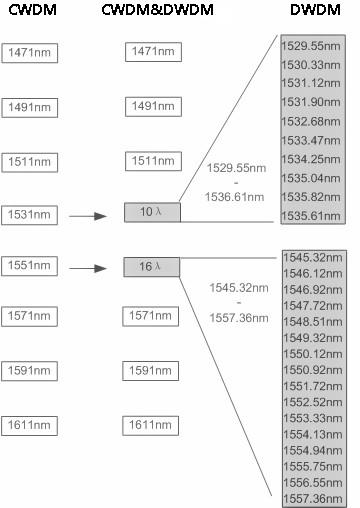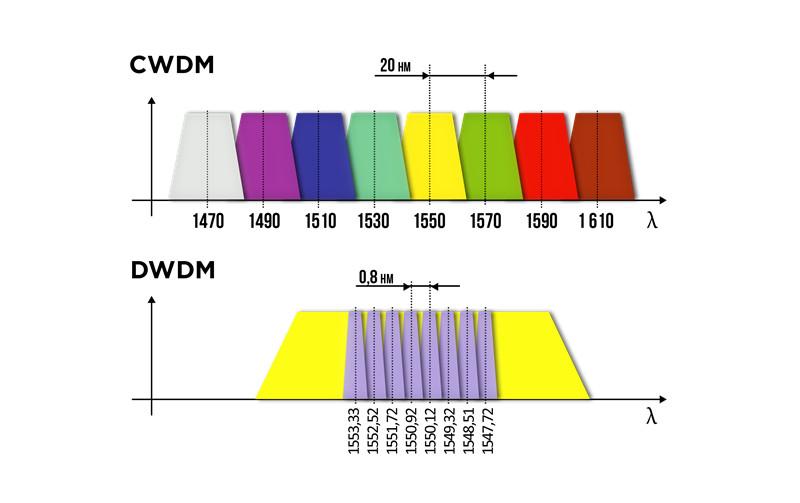- Related articles
- How to Test a Fiber Optic Transceiver?
- Optical Transceivers for Cisco WS-C3650-24PD-E Switch
- Optical Transceivers for Cisco N3K-C3064PQ-10GX= Switch
- What is Overhead Fiber Optic Cable?
- All Cisco CWDM-GBIC-1550's information (List price, Specs, Datasheet PDF, Compatibility ma
- What is Dark fiber?
- Optical Transceivers for Cisco WS-C3560-24TS-S Switch
- Optical Transceivers for Cisco N3K-C3548P-10G= Switch
- Optical Transceivers for Cisco N9K-C9396TX= Switch
- Optical Transceivers for Cisco WS-C3750E-24PD-E Switch

Introduction
Wavelength division multiplexing (WDM) technology is usually divided into coarse wavelength division multiplexing (CWDM) technology and dense wavelength division multiplexing (DWDM), widely used in a variety of optical communication network. Among them, DWDM system channel density is large, can reach 96, commonly used in long-distance high-bandwidth applications; CWDM system channel density is much smaller, usually, only 18, commonly used in short-distance transmission applications. These two WDM systems have advantages and disadvantages, so it was suggested that the combination of the two, this tutorial will introduce how to build CWDM & DWDM hybrid network.
Why can we build a CWDM & DWDM hybrid network?
CWDM & DWDM hybrid networks mean that DWDM wavelengths and CWDM wavelengths are combined, which is theoretically achievable because DWDM wavelengths are within the wavelength range of CWDM, as shown in the following figure, CWDM wavelength range is 1260nm- 1625 nm, the channel spacing is 20 nm, and the wavelength range of DWDM is 1470 nm to 1625 nm, and the channel spacing is 1.6nm (2000 GHz), 0.8 nm (100 GHz), or 0.4 nm (50 GHz).
Therefore, we can access the DWDM system to the CWDM network through 1470nm, 1490nm, 1510nm, 1530nm, 1550nm, 1570nm, 1590nm or 1610nm wavelength channels. However, in most practical applications, people usually use 1530nm and 1550nm two wavelength channels to build CWDM & DWDM hybrid network to expand the transmission capacity of CWDM network.
How do I build a CWDM & DWDM hybrid network?
The following describes how to build a CWDM & DWDM hybrid network with a 1550nm wavelength channel: a pair of CWDM multiplexers / demultiplexers with 1550nm channel ports and DWDM multiplexing / demultiplexes with a pair of wavelength channels near 1550nm (DWDM) multiplexer / demultiplexer is used to process DWDM wavelength signals, and then DWDM multiplexing / demultiplexing is used to multiplex / Multiple line ports of the multiplexer are connected to the CWDM multiplexer/demultiplexer, as shown in the following figure:

To successfully build a CWDM & DWDM hybrid network, you must carefully select the wavelength channels of the CWDM multiplexer/demultiplexer and the DWDM multiplexer/demultiplexer. The following figure details the channel wavelength used to build the CWDM & DWDM hybrid network. If you decide to introduce the DWDM multiplexer/demultiplexer using the 1530nm channel port on the CWDM multiplexer/demultiplexer, it is recommended that you select a wavelength channel range of 1529.55nm-1536.61 Nm DWDM multiplexing/demultiplexer; similarly, if you are using a 1550nm channel port to introduce a DWDM multiplexer, you should select a wavelength channel range of 1545.32 nm to 1557.36 nm.

Construction of CWDM & DWDM Hybrid Network with FMU Series Multiplexer/Demultiplexer
From the above we can see that the wavelength channel plays an important role in the CWDM & DWDM hybrid network, here describes a simple installation, the use of flexible multiplexer/demultiplexer to build CWDM & DWDM hybrid network-FMU series multiplexing / Demultiplexer. As shown in the following figure, the FMU Series Multiplexer/Demultiplexer is available in a 1/2 U plug-and-play modular package that can be loaded in a 1U FMU chassis for flexible wavelength selection.

As shown in the figure above, the 1U FMU chassis can accommodate any 2 1/2 U CWDM multiplexer/demultiplexer or 1/2 U DWDM multiplexer/demultiplexer. If you are building a CWDM & DWDM hybrid network, Simply insert 1/2 U CWDM multiplexer/demultiplexer and 1/2 U DWDM multiplexer/demultiplexer in the two slots of the 1U FMU chassis and connect the DWDM multiplexer/demultiplexer Of the Line port and CWDM multiplexer/demultiplexer, you can achieve in the 1U chassis CWDM & DWDM hybrid network. In addition, in order to ensure the transmission quality of the network, we also need to use fiber amplifier to amplify the optical signal.






































































